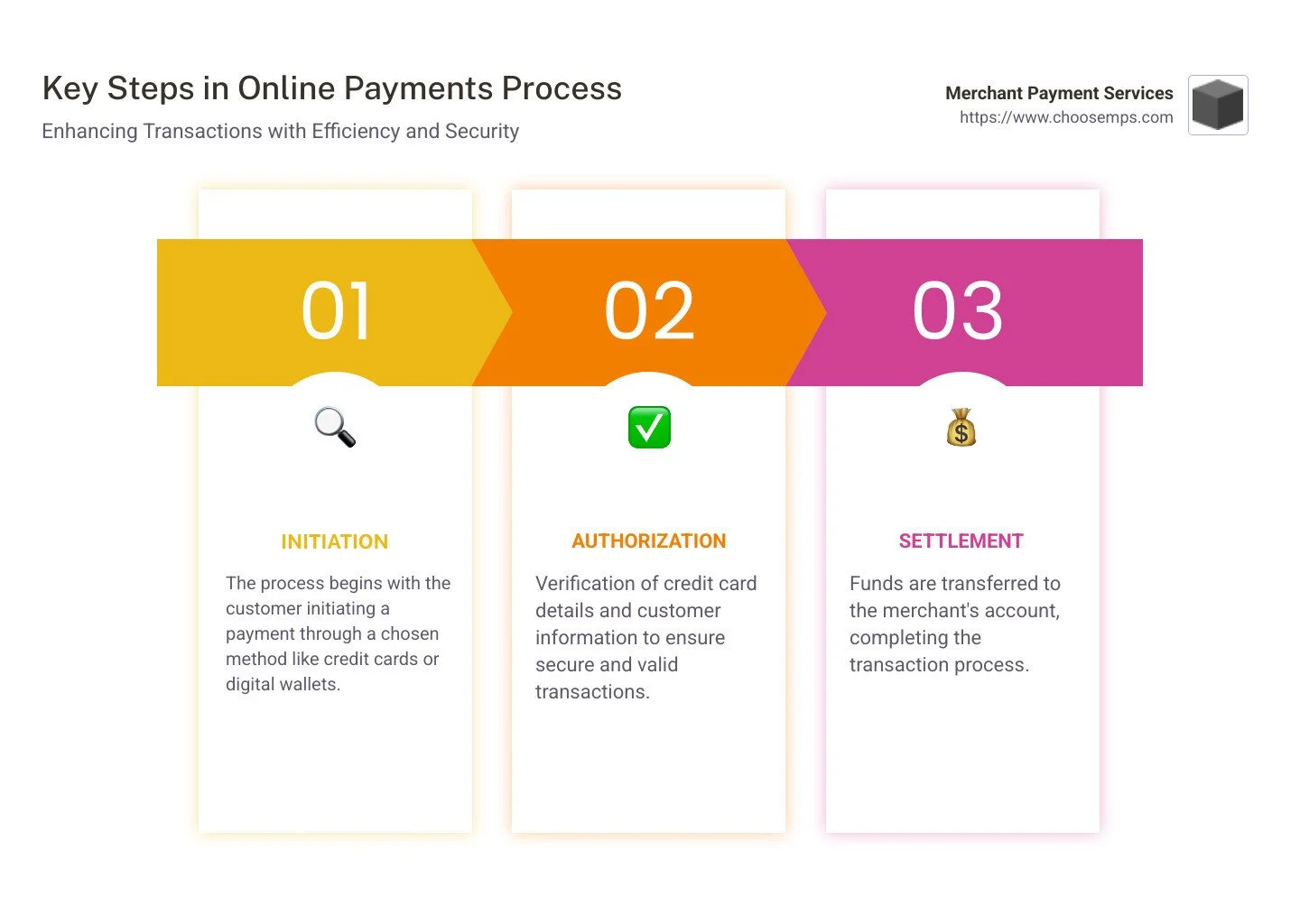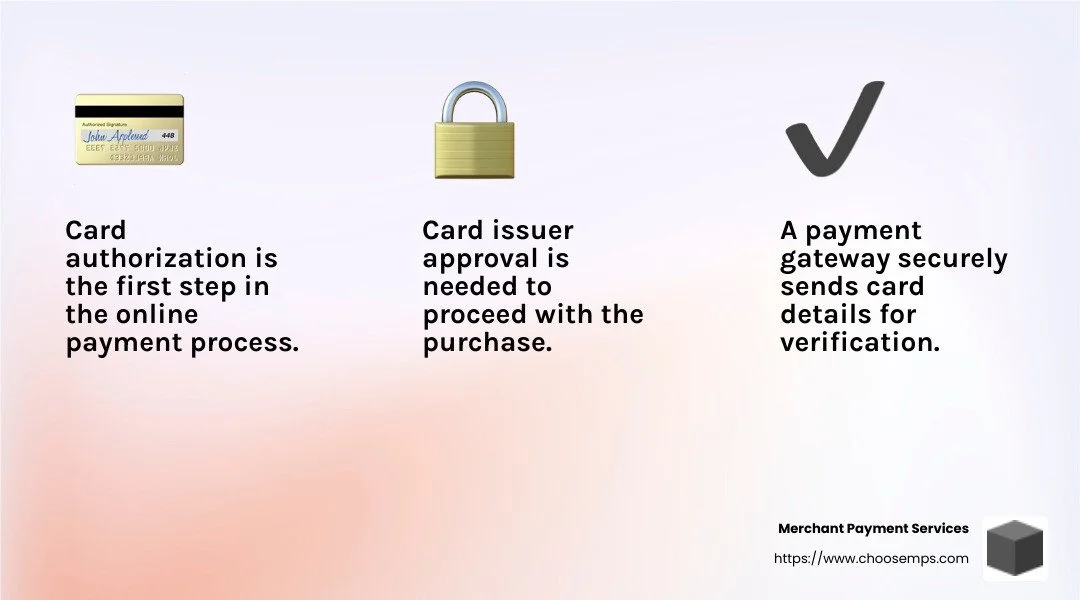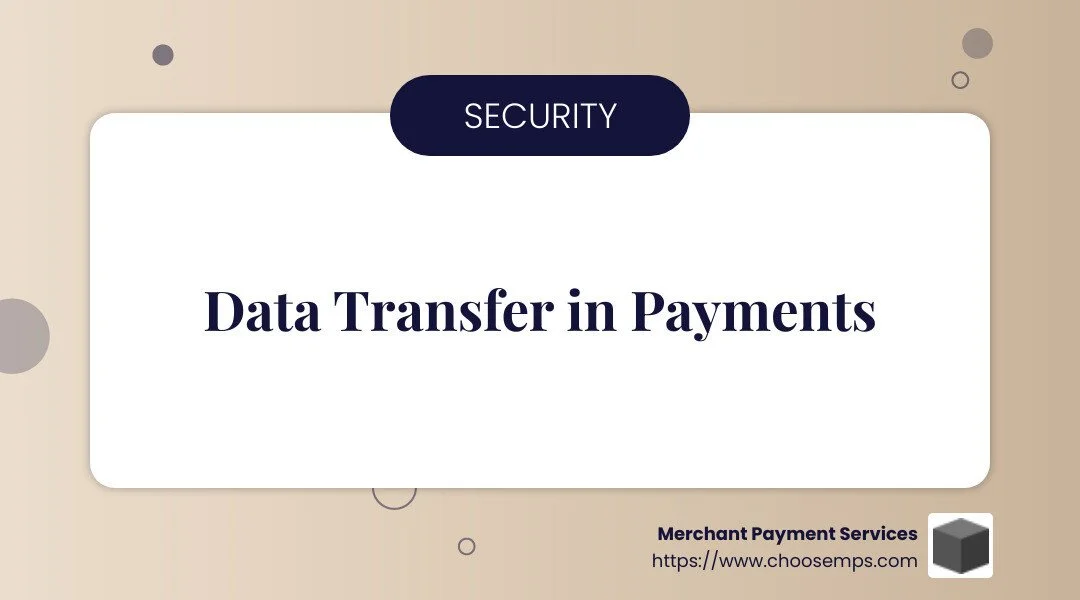Demystifying the Online Payment Process: A Beginner's Guide
Online payments process has become an essential aspect of modern business, providing a way for companies to receive funds electronically through various methods. Whether it's through credit cards, bank transfers, or digital wallets, enabling such payments is crucial for any business aiming to grow its online presence and meet customer needs efficiently. Embracing online payments is not just about convenience; it's about enhancing security, reducing fraud risks, and ultimately boosting your bottom line.
What is online payments process?
It's the sequence of steps that transfers funds electronically from a customer's bank to a business's bank account.Key Benefits:
Quick access to funds
Improved security measures
Reduced transaction fees
Streamlined accounting and reporting
Importance for Businesses:
Essential for e-commerce
Meets global customer demand
Allows 24/7 transactions
As the market for digital payment solutions rapidly expands, expected to reach $24.31 trillion by 2030, understanding the online payments process has become more critical than ever.
Allow me to introduce myself—Lydia Valberg, co-owner of Merchant Payment Services. With over 35 years of family-rooted experience in the field and a passion for simplifying complex financial processes, I've helped businesses optimize their online payments process with transparency and integrity.
Understanding the Online Payments Process
Navigating the online payments process can seem daunting, but once you break it down, it becomes much simpler. Let's explore the two main stages: card authorization and transaction settlement.
Card Authorization
Card authorization is the first step in the online payments process. It's where your customer's journey begins. Here's what happens:
Customer Inputs Details:
Your customer enters their credit card details on your website: card number, expiry date, CVV, and sometimes their billing address. It's crucial to ensure this form is easy to fill out to avoid errors.
Payment Gateway Role:
Once the customer clicks "Submit," the payment gateway takes over. This invisible tool securely sends the card details to the card issuer for verification. It checks if the card is valid and if there are enough funds.
Response from Issuer:
The card issuer sends a response back through the payment gateway. If approved, the purchase goes through. If not, the customer might need to correct their details or use another card.
Transaction Settlement
After the card is authorized, the next step is transaction settlement. This is where the money moves:
Payment Processor's Task:
The payment processor submits the transaction details to your bank. This can happen instantly or in batches at the end of the day.
Fund Transfer:
Your bank then communicates with the card network (like Visa or Mastercard) to ensure everything is in order. Once confirmed, the funds are credited to your merchant account.
Final Deposit:
Finally, the funds are transferred from the merchant account to your business bank account. This might take a few days, depending on your bank's policies.
Understanding these steps helps you see how crucial each component is—from the payment gateway ensuring secure data transfer to the payment processor handling the fund's journey. With this knowledge, you're better equipped to choose the right partners and tools for your business's online payments process.
Key Components of Online Payment Processing
When diving into the online payments process, understand the key components that make it all work smoothly. These are the payment gateway, payment processor, and merchant account. Each plays a vital role in ensuring secure and efficient transactions.
Payment Gateway
Think of the payment gateway as the digital equivalent of a point-of-sale terminal in brick-and-mortar stores. It acts as a bridge, facilitating secure communication between your website and the bank. Here's how it works:
Transaction Validation: The payment gateway verifies the card details and ensures the transaction request is legitimate. It acts as the first line of defense against fraud by encrypting sensitive information.
Secure Data Transfer: Once the card details are validated, the payment gateway securely transmits this data to the payment processor. This secure transfer keeps your customer's information safe from potential breaches.
Payment Processor
The payment processor is the workhorse of the online payments process. It handles the heavy lifting by managing the actual transaction settlement and fund transfer:
Transaction Settlement: Once the payment gateway transmits the transaction data, the payment processor communicates with the customer's bank to ensure funds are available. It then coordinates with the merchant's bank to settle the transaction.
Fund Transfer: After settlement, the payment processor ensures the funds are transferred from the customer's account to the merchant account. This step is crucial for the merchant to receive payment for the services or goods provided.
Merchant Account
A merchant account is a special type of bank account that holds funds from online transactions until they are transferred to the business's bank account. Here's what you need to know:
Holding Funds: The merchant account temporarily holds the funds during the settlement process. This is a critical step, as it ensures that the business receives the money owed after the transaction is verified and approved.
Transaction Fees: Opening and maintaining a merchant account typically involves fees. These fees can vary based on transaction volume and the merchant account provider. It's important for businesses to understand these costs to manage their expenses effectively.
Understanding these components helps explain the online payments process. Each part, from the payment gateway to the merchant account, plays a crucial role in ensuring secure and efficient online transactions. This knowledge empowers businesses to choose the right solutions for their needs, ensuring a smooth experience for both them and their customers.
Next, we'll explore the popular online payment methods that customers use every day to make purchases.
Popular Online Payment Methods
When it comes to the online payments process, there are several popular methods that customers use to make purchases. Let's explore the three most common ones: credit and debit cards, bank transfers, and digital wallets.
Credit and Debit Cards
Credit and debit cards are the backbone of online payments. They allow customers to pay for goods and services with ease. Here's how they fit into the process:
Card Information: Customers enter their card details, such as the card number, expiration date, and security code, into the online payment form. This information is then sent through the payment gateway.
Payment Gateway: The payment gateway plays a crucial role here by securely transmitting the card information to the payment processor. It ensures that the data is encrypted, keeping it safe from unauthorized access.
With credit cards, customers borrow funds from their bank, while debit cards deduct money directly from their checking account. Both options offer convenience, but credit cards often provide stronger consumer protections against fraud.
Bank Transfers
Bank transfers are another popular option, especially for larger transactions. This method involves moving money directly from the customer's bank account to the business's bank account.
Direct Transfer: Customers can initiate a bank transfer through online banking or mobile apps. This method doesn't require a payment gateway, as it involves direct communication between banks.
Online Banking: Many businesses offer the option to pay via bank transfer directly on their websites. This can be a secure and straightforward way to handle payments, especially for those who prefer not to use cards.
Bank transfers can take longer to process compared to card payments, but they often come with lower transaction fees.
Digital Wallets
Digital wallets are gaining popularity due to their convenience and security features. They allow customers to store and manage their payment information in one place.
PayPal, Apple Pay, Google Wallet: These are some of the most well-known digital wallets. They enable customers to pay with just a few clicks or taps, without having to enter their card details each time.
Secure Transactions: Digital wallets use advanced encryption and tokenization to protect sensitive information. They also offer additional layers of security, such as biometric authentication.
Digital wallets not only simplify the payment process but also improve security, making them a preferred choice for many online shoppers.
Understanding these popular payment methods helps businesses cater to their customers' preferences and ensures a seamless online payments process. By offering multiple payment options, businesses can increase their sales potential and improve customer satisfaction.
Next, we'll address some frequently asked questions about the online payments process to help clarify any lingering doubts.
Frequently Asked Questions about Online Payments Process
What is a Payment Gateway?
A payment gateway is like a digital bridge between a customer's payment and a business. It securely collects payment information and sends it to the payment processor for transaction authorization. Think of it as a virtual cashier that ensures your payment details are safe and sound.
Transaction Authorization: This is where the magic happens. The payment gateway checks if the payment details are valid and if the customer has enough funds. It sends the information to the payment processor, which then communicates with the card issuer to approve or decline the payment.
Secure Data Transfer: Safety first! Payment gateways use encryption to protect sensitive data like credit card numbers. This ensures that personal information stays confidential during the transaction.
How Long Does an Online Payment Take to Process?
The speed of an online payment process can vary, but usually, it happens in seconds. Here's a quick look at the timeline:
Processing Times: Most online payments are processed almost instantly. However, some factors like bank policies, weekends, or holidays can cause slight delays.
Card Issuer: The card issuer (your bank) plays a crucial role in this process. They verify the transaction and decide whether to approve or decline it. Once approved, the payment moves forward quickly.
What Are the Steps in the Payment Process?
Understanding the steps involved in an online payments process can help explain it. Here's a simple breakdown:
Transaction Initiation: The process starts when a customer decides to make a purchase and submits their payment information.
Payment Gateway: The gateway encrypts and forwards the payment details to the payment processor.
Payment Processor: The processor sends the information to the card networks (like Visa or Mastercard) and eventually to the card issuer for verification.
Authorization: The card issuer checks the transaction details and approves or declines the payment. This response is sent back through the chain to the payment gateway.
Reconciliation: Once approved, the funds are transferred from the customer's account to the merchant's account. This is the final step, ensuring that everything is in balance and the transaction is complete.
By following these steps, businesses can ensure a smooth and efficient online payments process. Understanding these elements helps clarify how money moves from a customer's account to a business's account, making online transactions seamless and secure.
Next, we'll explore the essential components of online payment processing to give you a deeper understanding of how it all works.
Conclusion
At Merchant Payment Services, we understand that navigating online payments can be daunting. That's why we're here to simplify the process and offer you the best payment solutions custom to your business needs. Our commitment to exceptional service and integrity sets us apart in the industry.
Our solutions are designed to make online payment processing as smooth and secure as possible. With our risk-free, month-to-month agreements, you can focus on growing your business without worrying about hidden fees or startup costs. Learn more about our online payment processing services.
We provide a range of services, from free terminals and POS systems to mobile payment options, ensuring you have everything you need to accept payments effortlessly. Our expert team is dedicated to helping you steer the complexities of online payments, offering support every step of the way.
By choosing Merchant Payment Services, you're selecting a partner that prioritizes your success. We believe that exceptional service goes beyond just providing technology; it's about building lasting relationships and ensuring your business thrives in the digital age.
Thank you for trusting us with your payment processing needs. We look forward to supporting your business and helping you achieve your goals.




